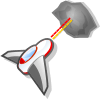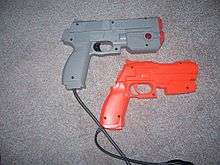Light gun shooter
| Part of a series on |
| Action games |
|---|
 |
Light gun shooter, also called light gun game or simply gun game, is a shooter video game genre in which the primary design element is aiming and shooting with a gun-shaped controller. Light gun shooters revolve around the protagonist shooting targets, either antagonists or inanimate objects. Light gun shooters generally feature action or horror themes and some may employ a humorous, parodic treatment of these conventions. These games typically feature "on-rails" movement, which gives the player control only over aiming; the protagonist's other movements are determined by the game. Games featuring this device are sometimes termed "rail shooters", though this term is also applied to games of other genres in which "on-rails" movement is a feature. Some, particularly later, games give the player greater control over movement and in still others the protagonist does not move at all.
Light gun shooters employ "light gun" controllers, so named because they function through the use of light sensors. Mechanical games using light guns had existed since the 1930s, though they operated differently from those used in video games. Throughout the 1970s mechanical games were replaced by electronic video games and in the 1980s popular light gun shooters such as Duck Hunt emerged. The genre was most popular in the 1990s, subsequent to the release of Virtua Cop, the formula of which was later improved upon by Time Crisis. The genre is less popular in the new millennium, as well as being hampered by compatibility issues, but retains a niche appeal for fans of "old school" gameplay.
Definition
"Light gun shooters", "light gun games" or "gun games" are games in which the protagonist shoots at targets, whether antagonists or objects, and which utilize a gun-shaped controller (termed a "light gun") with which the player aims. While light gun games may feature a first-person perspective, they are distinct from first person shooters, which utilize more conventional input devices.[1] Light gun games which feature "on-rails" movement are sometimes termed "rail shooters",[2] though this term is also applied to other types of shooters featuring similar movement.[3] The light gun itself is so termed because it functions through the use of a light sensor: pulling the trigger allows it to detect light from the on-screen targets.[4]
Design
Targets in light gun shooters may be threatening antagonists such as criminals, terrorists or zombies,[5][6][7] or they may be inanimate objects such as apples or bottles.[8] Although these games may be played without a light gun, the use of more conventional input methods has been deemed inferior.[5] Light gun shooters typically feature generic action or horror themes,[6][9] though some later games employ more humorous, self-referential styles.[10][11]
Light gun shooters primarily revolve around shooting large numbers of enemies attacking in waves.[10] The protagonist may be required to defend himself by taking cover,[2] or by shooting incoming thrown weapons, such as axes or grenades.[6] The player may also compete against the clock, however, with some games also featuring boss battles. Games may also reward the player for accurate shooting, with extra points, power-ups or secrets.[6][10] Games which do not pit the player against antagonists instead feature elaborate challenges constructed mainly from inanimate objects, testing the player's speed and accuracy.[8] More conventional games may feature these types of challenges as minigames.[6]
Light gun shooters typically feature "on-rails" movement, which gives the player no control over the direction the protagonist moves in; the player only has control over aiming and shooting.[2][10] Some games, however, may allow the protagonist to take cover at the push of a button.[2] Other games may eschew on-rails movement altogether and allow the player to move the protagonist freely around the game's environment;[12] still others may feature a static environment.[1] Light gun shooters utilise a first person perspective for aiming, though some games may allow the player to switch to a third person perspective in order to maneuver the protagonist.[12]
History

Mechanical gun games existed before the emergence of electronic video games, as far back as the 1920s.[4] The first light guns appeared in the 1930s, with the Seeburg Ray-O-Lite. Games using this toy rifle were mechanical and the rifle fired beams of light at targets wired with sensors.[4] These evolved throughout subsequent decades, culminating in games such as Sega's Periscope (the company's first successful game, released in 1966), which required the player to target cardboard ships.[13] Throughout the 1970s, mechanical arcade games were gradually replaced by electronic video games, following the release of Pong in 1972,[14] with 1978's Space Invaders dealing a yet more powerful blow to the popularity of mechanical games.[15] Light guns used in electronic video games work in the opposite manner to their mechanical counterparts: the sensor is in the gun and pulling the trigger allows it to receive light from the on-screen targets.[4] Computer light pens had been used for practical purposes at MIT in the early 1960s,[16] and the Magnavox Odyssey had a light gun accessory,[17] in the production of which Nintendo was involved.[18]
Light guns became popularly used for video games in the mid-1980s,[19][20] with Nintendo's Duck Hunt[1] and Taito's Operation Wolf being popular examples. Sega's Virtua Cop, released in arcades in 1994, broke new ground, popularized the use of 3D polygons in shooter games,[5] and led to a "Renaissance" in the popularity of arcade gun games. The game was inspired by the Clint Eastwood film Dirty Harry as well as a coffee advertisement in which a can of coffee grew larger in a gun's sights; in Virtua Cop the player had to shoot approaching targets as fast as possible.[21] The acclaimed Time Crisis by Namco, released in Japanese arcades in 1995 and Sony's PlayStation console in 1997, introduced innovations such as simulated recoil and a foot pedal which when pressed caused the protagonist to take cover. The game's light gun controller, the GunCon, was also acclaimed.[2][19] Namco also released Point Blank for the PlayStation in 1998 (previously available in Japanese arcades as Gun Bullet since 1994), a 2D sprite-based game featuring a unique minigame structure and quirky, humorous tone. The game was critically acclaimed and received two sequels, both for the PlayStation console.[8][22]
Light guns were suppressed for a time in the United States after the 1999 Columbine High School massacre and its attendant controversy over video games and gun crime.[19] Since the late 1980s light gun controllers have been generally manufactured to look like toys by painting them in bright colours. In Japan, which lacks the gun crime found in the United States and in which civilians cannot legally own guns, more realistic light guns are widely available.[19]
Light gun shooters are less popular in the new millennium than in the 1990s, with new games in the genre seen as "old school".[1][6][23] The Time Crisis and House of the Dead franchises continued to receive acclaimed installments,[6][10] with the arcade machine for the latter's House of the Dead 4 Special (2006) featuring large screens enclosing the player, as well as swivelling, vibrating chairs.[24] Some games attempted to incorporate elements of first person shooter or survival horror games through the use of less restricted character movement and exploration, with varying degrees of success.[6][12][25] Others, however, unashamedly paid homage to 1990s arcade gameplay, even embracing a somewhat parodic style.[10][11] Light guns are not compatible with modern high-definition televisions, leading developers to experiment with hybrid controllers, particularly with the Wii Remote for the Wii,[1][25] as well as the PlayStation 3's GunCon 3 peripheral used with Time Crisis 4. Others have used the PlayStation Move motion control system.[25]
See also
Notes
- 1 2 3 4 5 Casamassina, Matt, Controller Concepts: Gun Games, IGN, Sept 26, 2005, Accessed Feb 27, 2009
- 1 2 3 4 5 Ashcraft, p. 147
- ↑ Hilary, Goldstein, Panzer Dragoon Orta, IGN, Jan 10, 2003, Accessed Mar 1, 2009
- 1 2 3 4 Ashcraft, p. 145
- 1 2 3 Virtua Cop, IGN, July 7, 2004, Accessed Feb 27, 2009
- 1 2 3 4 5 6 7 8 Jeff Haynes,Time Crisis 4 Review, IGN, Nov 19, 2007, Accessed Mar 29, 2008
- ↑ Anderson, Lark, The House of the Dead 2 & 3 Return Review, GameSpot, Mar 29, 2008, Accessed Feb 27, 2009
- 1 2 3 Fielder, Lauren, Point Blank Review, GameSpot, Dec 23, 1997, Accessed Feb 27, 2009
- ↑ Davis, Ryan, Resident Evil: The Umbrella Chronicles Review, GameSpot, Nov 15, 2007, Accessed Mar 1, 2009
- 1 2 3 4 5 6 Anderson, Lark, The House of the Dead: Overkill Review, GameSpot, Feb 14, 2009, Accessed Feb 27, 2009
- 1 2 Davis, Ryan, Ghost Squad Review, GameSpot, Nov 28, 2007, Accessed Mar 1, 2009
- 1 2 3 Reed, Kristan, Resident Evil Dead Aim, EuroGamer, July 29, 2003, Accessed Feb 27, 2009
- ↑ Ashcraft, p. 133
- ↑ Ashcraft, p. 134
- ↑ Ashcraft, p. 136
- ↑ A History of the Internet, Computer History Museum, Accessed Feb 26, 2009
- ↑ The Ten Greatest Years in Gaming, Edge, June 27, 2006, Accessed Mar 1, 2009
- ↑ Martin Picard, The Foundation of Geemu: A Brief History of Early Japanese video games, International Journal of Computer Game Research, 2013
- 1 2 3 4 When Two Tribes Go to War: A History of Video Game Controversy, GameSpot, Accessed Feb 26, 2009
- ↑ The 30 Defining Moments in Gaming, Edge, Aug 13, 2007, Accessed Feb 27, 2009
- ↑ Ashcraft, pp. 145-46
- ↑ Davis, Ryan, Point Blank 3 Review, GameSpot, May 3, 2001, Accessed Mar 1, 2009
- ↑ Rosenberg, Adam & Frushtick, Russel, Best Light-Gun Game - Ghost Squad, UGO, Accessed Mar 1, 2009
- ↑ Ashcraft, pp. 147-48
- 1 2 3 Remo, Chris, Time Crisis 4 Review, Shack News, Nov 21st 2007, Accessed Mar 29, 2008
References
- Ashcraft, Brian (2008), Arcade Mania! The Turbo Charged World of Japan's Game Centers, Kodansha International